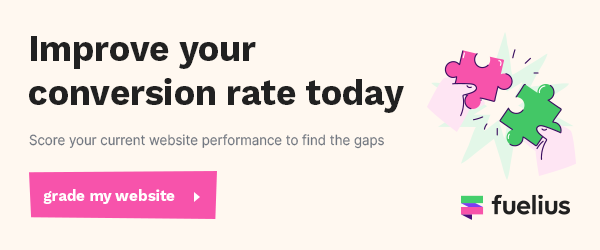
Think it's time to give your website a refresh? Since you've ended up here, you're probably at least considering a website redesign. Maybe your current one is feeling a bit tired, or you're not seeing the results you'd hoped for when it comes to traffic and conversions.
Developing a new website is no easy task. That's why we've put together a few things that can guide you through the process, from our experience as a web development agency. We've built a fair few in our time, so we'd like to hope our processes are pretty fine-tuned!
- How is your existing website performing?
- Consider your current traffic and conversion relationship
- Know your audience
- Scope out the competition
- Is your branding and messaging clear and concise?
- Keep SEO in mind
- Building your tech stack
- Get an instant website audit report
How is your existing website performing?
Before you even start to develop a new website, you should first take a long hard look at your current website to analyse what's working and what's not.
This will help you to understand what areas you need to improve when going through the development stages. Tools like Google Analytics should be your first port of call, as well as the likes of HotJar for gaining deeper insights and understanding of current user behaviours.
Analysing specific metrics that you want to focus on can put you in a better position moving forward. Metrics you want to analyse include:
- Bounce rate
- New leads
- New form submissions
- Number of unique visitors
- Time on site
- Pages that receive traffic
You can also put your current website into our website grader tool to measure its current performance. Once you have a new website, this will be a good benchmark to come back to!
Consider your current traffic and conversion relationship
One way to go about investigating the relationship between traffic and conversions; depending on how the two are connected, each of your website pages will fall into one of 4 likely categories:
High conversion, high traffic pages
→ These are the most precious and valuable pages for your organisation: any mistake you make here could have disastrous consequences, which is why you need to approach them with caution and 10x more care compared to everything else you are going to redesign on your website.
High conversion, low traffic pages
→ These pages are important because of the conversions they lead to, even if they don't currently have a lot of traffic, which means you need to approach the redesign with care so as not to break anything that is already working.
High traffic, low conversion pages
→ Traffic is high on these pages, but something is not working conversion-wise. Redesign while keeping improvement in mind: you're not risking conversions with the changes you make, so you can afford to be more experimental than in the previous two categories.
Low traffic, low conversion pages
→ Changes to these pages are probably not going to be noticed because of the low traffic, and you're not risking conversions anyway. Redesign all you want: these are the most risk-free pages on your site.
Why this is important? Understanding which pages must be preserved and handled with care will help you get the most out of your website redesign while making sure you a) don't break something that is working well and b) don't ruin conversion rates.
Know your audience
Knowing who exactly you are targeting is key when developing a new website. Your website should be primarily based around adding value to their specific user journey. As you are developing your website, you should ask yourself whether your branding aligns with your buyer persona and will it resonate with them.
Again, this is a great time to actually speak to your existing users through a survey, either onsite or hosted separately and run across your social channels and email.
Consider questions like...
- Did you find what you were looking for on our website?
- Was the website easy to use?
- Do you find the website visually appealing?
- Do you know any websites that have a great UX?
Scope out the competition
Take a look at your competitors. What features do they have on their website? What is the layout like? You could even run your current website through our free website grader tool to see how your site is performing and compare against competitors, noticing their strengths and weaknesses. Although you do not want to copy their design, it is advantageous to note what they are succeeding with.
It's also worth considering general websites that you like to use – both personally and professionally. At the end of the day, you're a consumer too, so next time you're on a website you particularly enjoy using, make sure you tag it in your bookmarks. Sometimes we can learn a lot from parallel industries and sectors that might be more innovative or forward-thinking than your own.
Is your branding and messaging clear and concise?
Before creating your new site and content, you should first make sure your branding and messaging is clear and concise. There should be no confusion about your proposition, who you are targeting, what you are selling and how it will benefit visitors.
As soon as they land on any page, it should be immediately clear what the business is and there should be a seamless journey throughout each section. The aim is to keep visitors on the site and not to leave to go to a competitor instead.
Both text and visuals should match your branding and tone of voice. If you have gone through a full rebrand including logo, colour palette and fonts this should all be applied and be seamless across the new website, emails, social media and any other methods used to get users to your site.
Keep SEO in mind
Getting discovered online is essential to growing your business and boosting sales. SEO is the way to do this. If no one can find your site, then you will not be able to reach your goals and improve your business. For each new page that you create, you should do thorough keyword research, sites that can help you do this include SEMRush and MOZ. Content can then be created with those keywords in mind, offering value and ranking higher on search engine results pages.
If you already have a live site, take advantage of marketing analytics tools to discover which pages are the highest performing. This will help you to understand which topics convert the most leads and find out what your audience is interested in. Keeping these pages and potentially just refreshing the content is a great way to keep the SEO credit that you have accumulated and make it simpler to rank on search engines.
There's also elements of technical SEO to consider, which form part of Google's Core Web Vital assessment criteria. This is all about making sure your website is technically optimised for search engines, looking at things like site speed, linking structure and code architecture.
Building your tech stack
There are countless considerations when it comes to the potential platforms you build your new website on.
Arguably the most important one is your content management system (CMS) – the physical system you'll use to house your web pages. Check out our CMS comparison for a quick overview of some of the most popular platforms on the market today.
There is a range of options to suit different skill sets, budgets and requirements, so it's worth investing time researching what's the right one for your specific business needs.
You'll also want to think about other systems that you currently use, whether it's a CRM, payment system, service provider etc. – anything that will need to be integrated into your new website to ensure it supports the entire customer journey.
Get an instant website audit report
If you want to know exactly where your specific website is going wrong, our free website grader tool can help. Simply plug in your website URL and wait a few moments before it provides you with a comprehensive breakdown of key performance areas like SEO, responsiveness and security.
You'll also get scored across each of these areas so that you're able to actively monitor any changes you make going forward. Most websites only score 60 out of 100! It also provides insights into how you can fix these components, or you can request a meeting with one of our website specialists who can go into more detail about areas for improvement.





